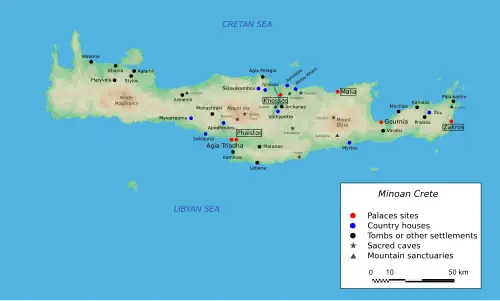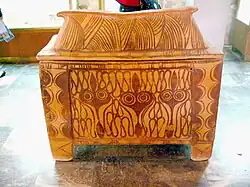Armenoi (archaeological site)
 Map of Minoan Crete | |
| Location | Rethymno, Crete, Greece |
|---|---|
| Coordinates | 35°19′05.05″N 24°27′48.65″E / 35.3180694°N 24.4635139°E |
| Type | Minoan cemetery |
| History | |
| Cultures | Minoan |
| Site notes | |
| Excavation dates | 1969-present |
| Archaeologists | Yiannis Tzedakis |
| Public access | Yes |
Armenoi is the archaeological site of an ancient Minoan cemetery on the north coast of Crete, roughly 8 kilometres (5 mi) south of the modern town of Rethymnon and close to the Minoan peak sanctuary at Vrysinas. It dates primarily to the Late Minoan II/IIIA/B period (c. 1470-1200 BC) though a single tholos type grave dates back to Late Minoan IB period (c. 1625–1470 BC). A single stirrup jar, found in a tomb, with the Linear B inscription "wi-na-jo" suggests there was some Mycenae contact in the later period of occupation.[1]
Archaeology

The site covers an area of about 35 acres. It is considered the most intact Minoan cemetery excavated. Only four of the tombs had been looted at the end of the Minoan period. Minor damage occurred during construction of a fortification by the German Army in WWII and by badgers using some of the tombs as dens.[2][3] Armeni has been under excavation since 1969 by Dr. Yiannis Tzedakis. 232 chamber tombs and one tholos tomb have been found. All chamber tombs date to the Late Minoan II/III period and the tholos tomb to the Late Minoan IB period.[4][5]
Tombs
The cemetery was planned, with paths and leveled areas. The tombs fall into three zones, A, B, and C. There are a few unfinished tombs where the ground proved too hard, which allows insight into the construction process. One tomb, the oldest, is of tholos construction with corbelled stones while the rest are chamber tombs. Chamber tombs consisted of a dromos (entrance way) which was dug first, and a chamber. The dromos had either steps or a ramp and was typically between 1.5 meters and 2.5 meters in width and between 3.5 meters and 7 meters in length (one exemplar is 16 meters long). The tombs appear to have been used as family burial site with new remains added over time (17 skeletons were found in one tomb). Chamber tombs were oriented to the east with dromos angle ranging from 52.5 degrees to 133 degrees, toward the Minoan peak sanctuary at Vrysinas.[6] Some of the tombs contain "benches, pillars, conches, or crypts, which sometimes contained votives or traces of bones, in the floor or the walls of the dromo".[7] Some of the tombs had larnakes (small clay coffins) usually containing a single skelton. A few of the larnakes have polychrome painting, one with a hunting scene with 4 dogs, 2 stags, and an agrimi (Cretan wild goat) and others with animals (octopus, deer and birds), geometric designs, or symbols (such as Horns of Consecration).[7][8]

Large amount of pottery were found in the tombs, primarily jugs, pyxides, kraters, alabastra, amphorae, stamnoi, stirrup jars, and incense burners. The Minoan chronology is based on pottery so tombs could be closely dated. Kylixs and cups were found to contain the residue of "greek grog", an alcoholic beverage made from grains, honey, herbs, fruits, and occasionally even grape wine leading to suggestions they were used as part of funerary ritual.[9] Other tomb finds included a boars tusk helmet. spindle whorls, beads, clay idols, bone pins, and an ivory combs thought to have been an import from Egypt or Syria. A number of bronze grave goods were recovered including rings, daggers, spearheads swords, tools, and vases. A few gold beads and silver rings were also found.[7]
A number of soft stone lentoid Minoan seal-stones, of a style usually called Cretan Popular Group, were found at the site as well as a boars tusk helmet. A few cylinder seals were also found. Other seals were made using rock crystal, serpentine, sardium, faience, or glass paste.[10] A single stirrup jar, found in a tomb, with the Linear B inscription "wi-na-jo" suggests there was some Mycenae contact in the later period of occupation. The same inscription was found on a stirrup jar excavated at Dendra. The same scribe wrote on a stirrup jar found at Knossos.[1][11] A stone amulet was found in a tholos grave from the Linear Minoan IB period inscribed with a combination of two Linear A ideograms.[2]
Human remains
Over 1000 individuals (200 were articulated primary burials and 800 were secondary co-mingled burials) have been recovered from the tombs with more males than females (143 males to 107 females).[5] Average age at death is estimated to have been 30-35 years.[11] An osteoarchaeological study of some of the remains found 250 adult and 106 child skeletons.[7] The isotope composition and genetics of some of the skeletons has been analysed indicating that four of the buried did not come from the local area.[12][13] DNA analysis of several samples (Tomb 230, tooth) found the mtDNA haplogroup of H59, which is common in the area.[1] Based on the characteristic lesions on the vertebrae 15 possible cases of TB and two possible cases of brucellosis were noted on the skeletons.[14] Facial reconstructions were created for two individuals (Tomb 132).[15]
"one individual seems to have met a very violent death. The deceased was about twenty-five years old, fairly tall and robust. On several parts of the body (arm, thigh and shins), there are some ten cut marks which must have been caused by blows from a sharp, heavy instrument: probably an axe. His right hand was completely severed at the middle of the forearm. It has been suggested that his premature and violent death was the result of a duel or murder, although execution or even torture cannot be excluded"[16]
Town
Given the numerous tombs and wealth of grave goods, the necropolis appears to have served a large and prosperous nearby settlement. The excavators have proposed that this town was located at the modern village of Kastellos, where archaeological surveys and trial excavations have found evidence of LM III occupation.[4][5]
Tourism
The site is open to tourists, including entrance into several of the main rock-cut tombs. Automatic lighting has been installed. There is an entrance fee of €3. Artifacts from the site can be found at the Archaeological Museum of Chania and the Rethymno Museum[17]
See also
References
- ^ a b c [1]Richards, Michael, et al., "Finding mycenaeans in minoan crete? Isotope and DNA analysis of human mobility in Bronze Age Crete", Plos one 17.8, e0272144, 2022
- ^ a b [2]Papathanassiou, Maria, Michael Hoskin, and Helen Papadopoulou, "Orientations of tombs in the Late-Minoan cemetery at Armenoi, Crete", Journal for the History of Astronomy 23.17, pp. S43-S55, 1992
- ^ Papathanassiou, Maria, Michael Hoskin, and Helen Papadopoulou, "Orientations of Tombs at Armenoi, Crete: Addenda", Journal for the History of Astronomy 24.18, pp. S54-S54, 1993
- ^ a b Yannis Tzedakis, Holley Martlew, and Robert Arnott, "Late Minoan III Necropolis of Armenoi Volume I: Introduction and Background", INSTAP Academic Press, 2018 ISBN 978-1-93153498-7
- ^ a b c Yannis Tzedakis, Holley Martlew and Michael Tite, "The Late Minoan III Necropolis of Armenoi Volume II - Biomolecular and Epigraphical Investigations", Oxbow Books, 2024 ISBN 9798888570463
- ^ Papathanassiou, Maria, and Michael Hoskin, "The Late-Minoan cemetery at Armenoi: a reappraisal", Journal for the History of Astronomy 27.1, pp. 53-59, 1996
- ^ a b c d [3]McGeorge, P. J., "The Minoans: demography, physical variations and affinities", PhD thesis, University of London, 1983
- ^ Bloedow, Edmund, "The Significance of the Goat in Minoan Culture", Praehistorische Zeitschrift , vol. 78, no. 1, pp. 1-59, 2003
- ^ McGovern, Patrick E., "Lands of Dionysos: Greece and Western Anatolia", Ancient Wine: The Search for the Origins of Viniculture, Princeton: Princeton University Press, pp. 239-278, 2019
- ^ [4]Younger, John G., "Aegean Seals of the Late Bronze Age: Stylistic Groups, VI. Fourteenth Century Mainland and Later Fourteenth-Century Cretan Workshops", Kadmos 26, pp. 44-73, 1987
- ^ a b [5]Foody, M. George B, Genetic impact of the Bronze Age at the fringes of Europe", Diss. University of Huddersfield, 2021
- ^ Lazaridis I, Mittnik A, Patterson N, Mallick S, Rohland N, Pfrengle S, et al., "Genetic origins of the Minoans and Mycenaeans", Nature, 548(7666), pp. 214–218, 2017
- ^ Tzedakis, Yannis, and Holley Martlew, "A chorotaxia at the Late Minoan III cemetery of Armenoi", Krinoi kai limenes Studies in Honor of Joseph and Maria Shaw, pp. 67-73, 2007
- ^ [6]Alušík, Tomáš, "Epidemic, Infectious and Parasitic Diseases in Prehistoric Greece", Sympozjum Egejskie: Papers in Aegean Archaeology 3, pp. 13-19, 2022
- ^ Prag, John, "From the Caves of the Winds to Mycenae rich in gold: the faces of Minoan and Mycenaean women", Women in Antiquity, Routledge, pp. 561-572, 2016
- ^ Georganas, Ioannis, "Warrior graves’ vs. warrior graves in the Bronze Age Aegean", Warfare in Bronze Age Society, pp. 189-197, 2018
- ^ "Minoan Crete -- Armeni Late Minoan cemetery". www.minoancrete.com. Retrieved 2022-07-01.
Further reading
- L. Godart and Y. Tzedakis, " Archaeological evidence et épigraphiques en Crète occidentale du Néolithique au Minoen Récent III B", Incunabula Graeca 93, 1992
- L. Godart and Y. Tzedakis, "La storia della Lineare B e le scoperte di Armenoi e la Canea", RivFil 117, pp. 385-409, 1989
- McGeorge P.J.P., "Preliminary report: human skeletons from the Armenoi excavation 1976", AAA 13:2, pp. 196–197, 1980
- Richards M, "Hedges R. Stable isotope results from the sites of Gerani, Armenoi and Mycenae", Archaeology meets science: biomolecular and site investigations in Bronze Age Greece Oxford: Oxbow Books, pp. 220–30, 2008
- [7]Skourtanioti, Eirini, et al., "Ancient DNA reveals admixture history and endogamy in the prehistoric Aegean", Nature ecology & evolution 7.2, pp. 290-303, 2023
- Tzedakis, Yannis, and Holley Martlew, "Armenoi: The Late Minoan III Necropolis and the Town", Philistor. Studies in Honor of Costis Davaras, pp. 239-246, 2012